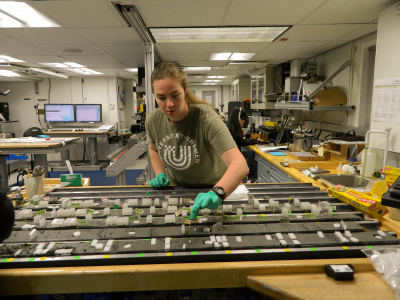Die Inhalte dieser Seite sind leider nicht auf Deutsch verfügbar.
Seitenpfad:
- Graduate School GLOMAR
- Admission
- Elizabeth A. Brown
Elizabeth A. Brown
Report of Guest PhD student Elizabeth A. Brown about her research placement at MARUM from August - October 2013
GLOMAR’s assistance allowed me to study at MARUM and the University of Bremen from August – October of 2013. My goal was to assess geographic and geochemical differences between two morphotypes of the planktonic foraminifer Globigerinoides ruber in the micropalaeontology lab of Prof. Dr. Michal Kucera. This project was done using core-top samples from METEOR cruise 35 and METEOR cruise 78/1. A random 300-count of all planktonic foraminifera was picked from the < 200 µm size fraction, and G. ruber (white) specimens were set aside to be grouped by morphology. Additional samples were taken back to the University of South Florida at the end of October 2013 for isotopic analysis (δ18O and δ13C). These will eventually be published as a map from which we can evaluate how the isotopic offset between the morphotypes varies spatially.
During my stay in Bremen, I was also able to participate in the 2013 ECORD workshop on deep sea sediments, from which I received insight and input on both my short-term work at MARUM, and my PhD research in general. I also joined the micropalaeontology laboratory’s trip to the island of Helgoland, which was wonderful.
Analysis of the M35 and M78/1 G. ruber is still ongoing, but the early results are already at work. The three months’ research in Bremen provided support for my PhD dissertation proposal to compare multiple influences on G. ruber morphology (spatial, temporal, and seasonal distribution). Preliminary results of the project were also included in a grant application to the Fulbright Program, which was accepted just a few days ago. In August 2014, I am scheduled to return to Germany for one academic year, again drawing on Dr. Kucera’s expertise as I analyze newly acquired Pleistocene-Pliocene fossil foraminifera from the recently completed IODP Expedition 349.
I want to thank the GLOMAR Research Placement Programme for its instrumental assistance in the early stages of this study. I created a new data set, gained new colleagues, and learned a great deal more about G. ruber and foraminiferal classification, as well as experiencing life and academia in Europe for the first time. My dissertation is much stronger now, and my time as a guest PhD student at MARUM was critical in convincing Fulbright of the importance of collaborating with MARUM during my doctoral studies. Thank-you very much for your support!
During my stay in Bremen, I was also able to participate in the 2013 ECORD workshop on deep sea sediments, from which I received insight and input on both my short-term work at MARUM, and my PhD research in general. I also joined the micropalaeontology laboratory’s trip to the island of Helgoland, which was wonderful.
Analysis of the M35 and M78/1 G. ruber is still ongoing, but the early results are already at work. The three months’ research in Bremen provided support for my PhD dissertation proposal to compare multiple influences on G. ruber morphology (spatial, temporal, and seasonal distribution). Preliminary results of the project were also included in a grant application to the Fulbright Program, which was accepted just a few days ago. In August 2014, I am scheduled to return to Germany for one academic year, again drawing on Dr. Kucera’s expertise as I analyze newly acquired Pleistocene-Pliocene fossil foraminifera from the recently completed IODP Expedition 349.
I want to thank the GLOMAR Research Placement Programme for its instrumental assistance in the early stages of this study. I created a new data set, gained new colleagues, and learned a great deal more about G. ruber and foraminiferal classification, as well as experiencing life and academia in Europe for the first time. My dissertation is much stronger now, and my time as a guest PhD student at MARUM was critical in convincing Fulbright of the importance of collaborating with MARUM during my doctoral studies. Thank-you very much for your support!



